September 2017 brought Hurricane Irma; the first category 5 hurricane to be recorded in the Leeward Islands (before Maria showed up 2 weeks later). It had maximum wind strength of 180mph and waves of around 10m in some places. Across the region there were at least 134 Irma-related deaths. Landfall was in Antigua and Barbuda, Saint Martin, the Bahamas and Cuba, and it damaged 95% of buildings in Saint Martin. For many in the most affected areas, Irma felt like the apocalypse and looting and social unrest were rife. Many people lost everything. (Read more on Wikipedia.) For boat people, hurricanes are an annual anxiety and avoiding them or preparing for them is many folks’ number one occupation. The bateau and I were in Guadeloupe for Irma and Maria (and Jose) in 2017, and although we escaped damage, it was stressful and scary.
Hurricanes 101
A hurricane is a type of tropical cyclone, and is formed by the warm moist air rising off a warm ocean, causing an area of low pressure below it. Air from the high pressure areas surrounding this is pushed back into the low pressure, warming up again, and rising, eventually causing a spinning effect. The rotation increases in intensity, forming an eye of very low pressure in the centre. (For the difference between low and high pressure, think low pressure = rain and clouds and general unsettledness, high pressure = dry sunny days.) Landfall often weakens the systems since they rely on the warm moist air coming off the ocean for fuel.
In the Caribbean hurricanes usually begin life as tropical waves off the coast of Africa, then becoming tropical depressions, intensifying into tropical storms, and then eventually full-bodied hurricanes as they march across the Atlantic. Storms are officially classed as hurricanes when wind speeds reach 74mph. Over here we have a lot of issues with Saharan dust clouds (‘Brume de Sable’ in Martinique) causing difficult breathing conditions, but the silver lining of these is that they can serve to discourage hurricanes from forming since hurricanes need moist air. The season in the Caribbean lasts roughly between the beginning of June and end of November and it gets more risky towards the end of the ‘summer’ as the hot weather has spent the season nicely warming up the ocean. Once a hurricane has passed, it cools down the sea enough to reduce the power of a second one following on its heels. This is why in 2017 after Irma, Jose lost much of its power, but it wasn’t enough to kill Maria.
Very few boats survived Irma as it rampaged through islands to the north of us (particularly St Martin). I have two friends who miraculously did – one in a marina and one in the lagoon’s mangroves (mangroves are a delicate eco system protecting the coasts from erosion by storms, and are a go-to hurricane protection area for boats). They’ve kindly shared their experiences of how they prepared, and the damage they sustained afterwards:
Erika on Alexa (Barchettalove)
We were in Saint Martin in Simpson Bay, IGY marina, and we are basically the only boat that survived and had no major damage. We have been able to sail away with our own boat some months after. What saved our boat for sure is 50% luck and some stronger power plus another 50% preparation.
We got a double spot inside the marina, so between the two fingers of the dock we were the only one. This is what every marina should do. We started one week earlier taking out everything possible, leaving the boat the most naked we could. A bare hull with a mast! We placed the boat in the middle between the two fingers and put out 19 chains and ropes. Only two of them were tied on the dock, and for all the others we dived and placed them under water on the concrete pylons that held the dock, like it was a spiderweb. We finished the job the day before with the last 4 chains that we put at the stern. We needed to be sure no boats were still passing or they could get stuck in them. Before leaving we also set a stern anchor. Ropes and chains shouldn’t be too tight because when the hurricane comes the boat literally jumps! So you need to leave her enough space to not break them but still not too much, to allow chains and ropes to do their job.
We didn’t empty the boat, there was no time. We trusted that we would find everything there where we left it. We just packed 3 suitcases and a couple of bags with the necessary things and with what we really didn’t want to lose. We stayed in a hotel just in front of the marina from where we would be able to see that our boat was still there when everything ended. Also there is a specific plan in choosing the right spot we needed as a shelter: a concrete building aparthotel (with kitchen), 4th floor, not too high, not too low for the impact with the wind and to be able to watch the boat. A central room, behind the stairwell.
After the storm we had minor damage. My neighbour’s boat sank and his mast fell on our boat, taking with it one shroud and basically all the stainless steel on the left side of the boat and twisting the steel of the bow. Nothing that couldn’t be fixed. We even sailed from Saint Martin to Antigua a few months later; we just couldn’t use the jib because the roller got damaged in the twisting I mentioned.
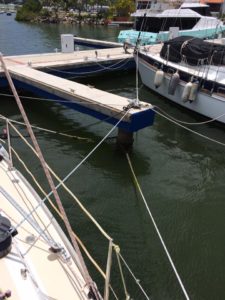
Image Credit: Erika Storelli
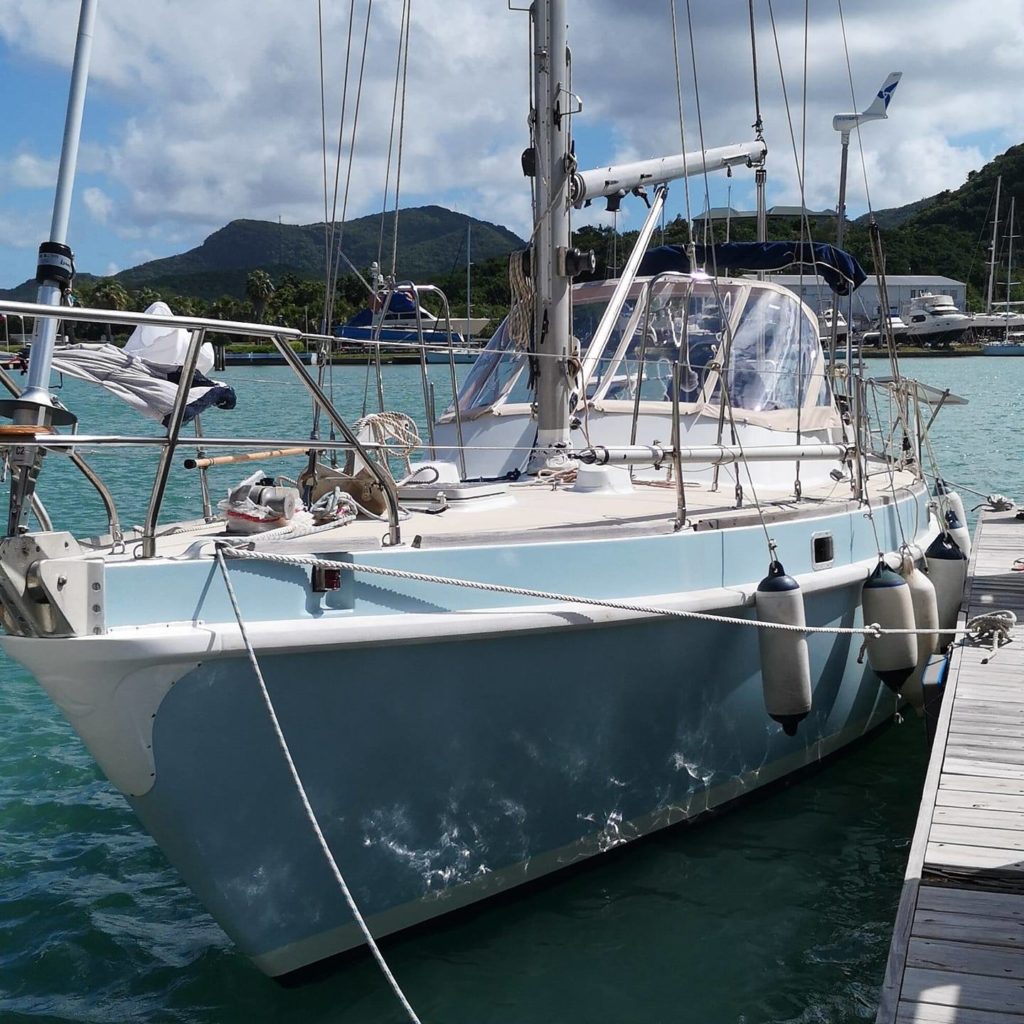
Image credit: Erika Storelli
‘Gringo’ Ben on Mistress
Without the luxury of a marina berth, Ben and Mistress spent Hurricane Irma in the mangroves on the French side of Simpson Bay Lagoon in St Martin. He says he was one of the only surviving boats in this lagoon, and a lot of that can be put down to his very thorough preparations in the days leading up. When you hope to survive a hurricane, preparation is everything. Here’s an extract from his Facebook commentary (which gives a good insight into the sort of calculations that should be going through a captain’s mind at this sort of time):
For a previous hurricane I’d gone to the mangroves on the Dutch side near the golf course. It’s a very good spot but everyone’s first choice and very tightly packed. I figured correctly that I’d not get in there. I opted for a much less well protected stretch of mangrove on the French side, much less competition for space but shit drunk aggressive neighbours.
Sept 3rd: Tied up in mangrove as planned. There were several other boats there already and I slotted in between two. Tight squeeze, not ideal, but hopefully one or both of my neighbours will adjust their lines to make some room (they have room the other side). I’ll put anchors out tomorrow, opposite side to the mangroves, to pull us away from shore – that will be where the worst winds come from. If we do get pushed ashore, it is soft mud and mangroves. All good.
Sept 4th: I’ve been back in the water this morning. I didn’t lay out anchors as I found better strong points to work with – one large iron thing that looks like part of an old crane, and two large sections of concrete with bits of rebar conveniently poking out. I’ve attached chain to these to avoid any chafing problems, and shackled 3/4″ nylon rope to the chain. These three lines cross the channel which services the boat yard and the gas station of this little cul-de-sac, so I can’t tighten them until tomorrow afternoon when nobody will be moving. At that point, everybody will tighten their lines and it will look like that game you play with string – cat’s cradle. My boat faces north on the east side of this channel, the mangrove on my starboard side. I have four lines into the mangrove currently, including two spring lines designed to stop the boat moving forward or back into my neighbours (I hope).
(My key tips: use old car tires to provide snubbing shock absorbers in lines. And don’t double up ropes as you don’t double the strength – one side will always take more stress then fail, quickly followed by the other.)
To my west across 150 feet of water is Time Out Boat Yard. One of my lines to that side is directly adjacent to me. The other two are much longer, diagonally from my bow and stern. These lines will hold Mistress off the shore when the wind blows from the NW W and SW.
I’ve not yet rigged up any chafe protection and I’m trying to figure out alternative strong points on the boat to secure lines to. I’ll be using the jib sheet winches, as well as the fore and aft cleats. I’ve also created a ring of rope around the mast which I shall put some lines to in case my cleats don’t hold. In fact I think I’ll create a spiders web of lines providing backup to the cleats just in case.
Twenty foot waves are predicted, but we shouldn’t see them in here. There will be a substantial storm surge to take into consideration when adjusting the lines, but I can’t give too much slack as that will allow too much movement in the small space available. Should Mistress be blown ashore here, the soft mud slopes steeply here, and I don’t think it would be too much of a problem. It’s the other boats that could sink her. The wind will initially come from the North, and swing around to come from the West, and continue around to the South. There are no boats to the west of me, unless they get blown off their stands in the boat yard – which could happen. There about half a dozen boats north of me, on Mediterranean style moorings. If they should go, they’ll drift down onto Mistress and crush her like an egg. Likewise, there are boats in the lagoon south of me, potentially many many boats which could (and will) break free and find themselves down my end, however most will run aground before coming anywhere near – I hope.
We’ll be leaving Mistress to look after herself during the hurricane. It breaks my heart to do so, and I’m still very tempted to stay. I’m told there is nothing you can do during the storm to save your boat if it comes to it, but I am not convinced. If a line parts, there’s a reasonable chance I could rig another. People would say it is not worth the risk, and certainly if your boat is a recreational toy, and insured, it would be insane. But Mistress is my home, my only home, on which I keep everything I own. If putting out one extra line during a storm would save her, it seems not an unreasonable risk… What do you pack when you leave your home knowing there is a strong possibility it will be destroyed in your absence?
After the storm: Mistress was afloat, not far from where I left her. Afloat, but far from unscathed. She’d lost her mizzen mast: broken in two, as I would later figure out, and submerged beneath Mistress, suspended by the rigging wire and halyards. The main mast remained, but it was a miracle since one spreader had been smashed away completely, and the other significantly dented. One lower shroud was hanging overboard, the rest flapping about loose.
None of my neighbours’ boats kept their masts – in fact, few boats remained at all. One was sunk opposite me, although it turned out not to have been one of the boats moored there before the storm hit. A catamaran floated with a significant list. A pile of motor boats could be seen at the end of the little cul-de-sac. My immediate neighbours were both pushed up on the banks, tipping over as the storm surge retreated. Mistress had been rubbing up against the fallen mast of one, and despite a few fenders, her hull showed deep heart-breaking scars that made me feel her sailing days were well and truly over. Those wounds were not the only damage to her hull. Along with numerous other battle scars, she was holed in three places, above the water line fortunately. One of the holes still contained the weapon used against her: a five foot length of aluminium which I later figured out were the frames of the hundreds of solar panels which previously adorned the roof of the nearby stadium. The angle at which the javelin-like aluminium frame pierced Mistress’s hull revealed that she must have been heeled over completely at the time, knocked over to such a degree that her masts would have been in the water.
Ben gave a fascinating blow-by-blow commentary throughout the hurricane (while he still had electricity) – too long to include here but offering great insight into the atmosphere and experiences of boaters there. A year or so later, after completing his own hefty repairs, he was back terrorising the Caribbean again.
Meanwhile in Guadeloupe…
Back on Annie B, I prepared as best I could, taking my cue from the other guys in the marina. Some people were still leaving, trying to get as far south as possible before the nightmare hit; but with no engine and no strong sailing skills I had little choice but to stay. There was a definite feel of camaraderie in the place, with teams helping some take down their masts, and others delivering old car tyres which local garages were making available for free. The young pirates were fighting with the Capitainerie to do more about the abandoned boats that, without proper securing, were a danger to everyone else.
I had some help to take my sails off (with another horrifying trip up the mast as the genoa was stuck). I also removed the aluminium scaffolding that had been providing my cockpit shelter. This was disturbingly easy to do as I could just wobble it then pull it off with my bare hands – the storm would have made light work of that, and another reason not to re-install it later. I deflated the dinghy and stored it inside, and lashed down the engine that was still taking up space on the cabin floor (the boat would be heeled over during the storm and I needed to prepare the interior as if we were going out to sea). Everything that could be removed from the deck and cockpit came off and was hidden inside, and the enormous 30kg outboard engine (which I needed assistance to move from a team of friendly young guys – sometimes it helps being the only single woman in the marina) snuggled on the cockpit floor. Every rope that might otherwise fly wild was secured to the mast, the rudder lashed down and the boom lowered and wrapped in cloth to prevent chafing. This I tied to the winches to stop it moving about. I drifted the bateau back so my mast wouldn’t tangle with my neighbour’s, doubled all the mooring lines and installed tyres as extra fenders. These you needed to run a line through under the hull so they wouldn’t fly up in the winds (and dress up in a t-shirt to avoid staining your hull). The solar panels came off and also hid themselves in the cabin. I tied plastic bin liners round the ventilation ducts to stop too much rain getting in, and then I was about as ready as I could be. I didn’t have insurance that would protect me from hurricane damage, but I took photos nonetheless (this is important to prove that you really have done all you can to protect the boat from the storm).
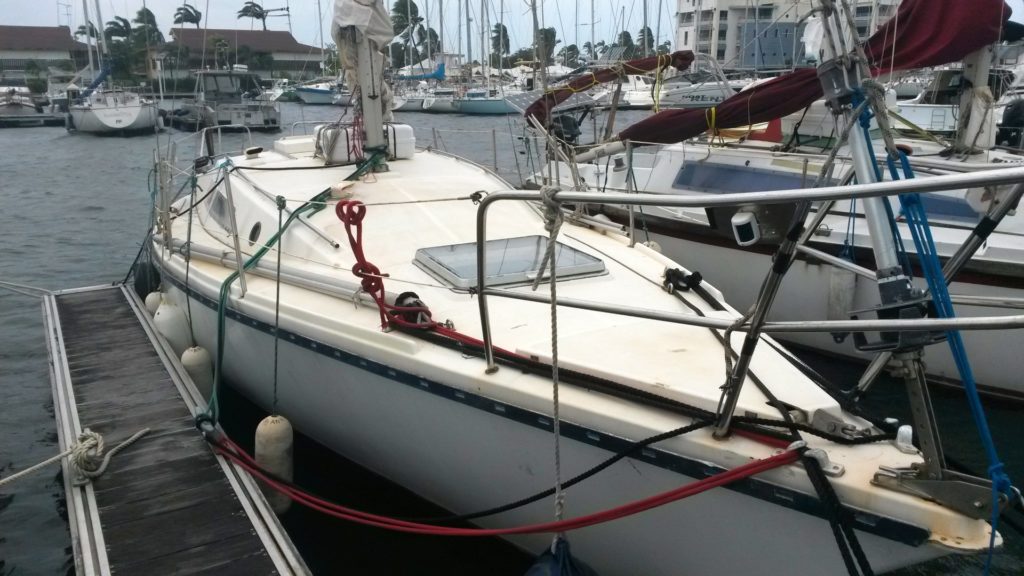
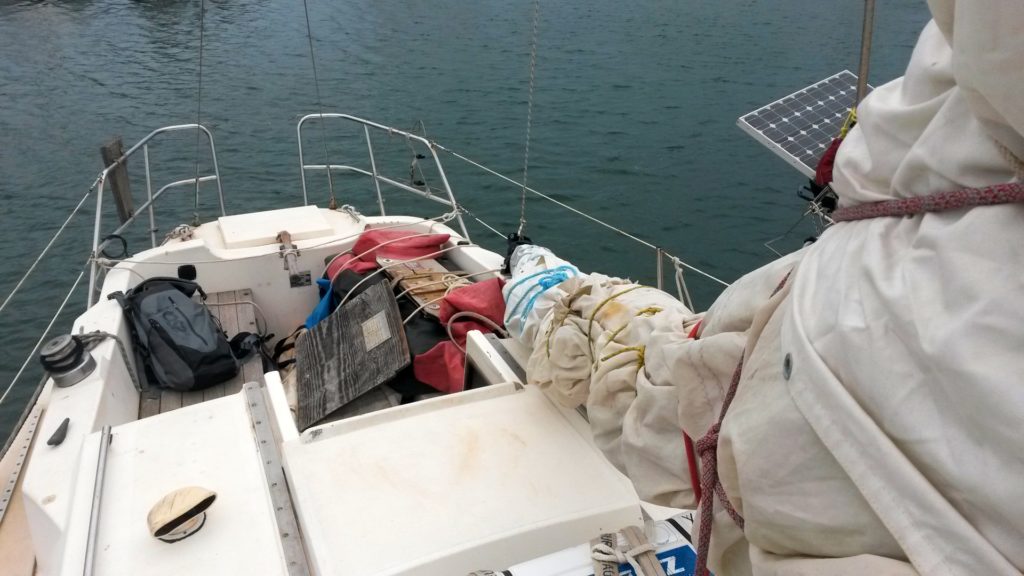
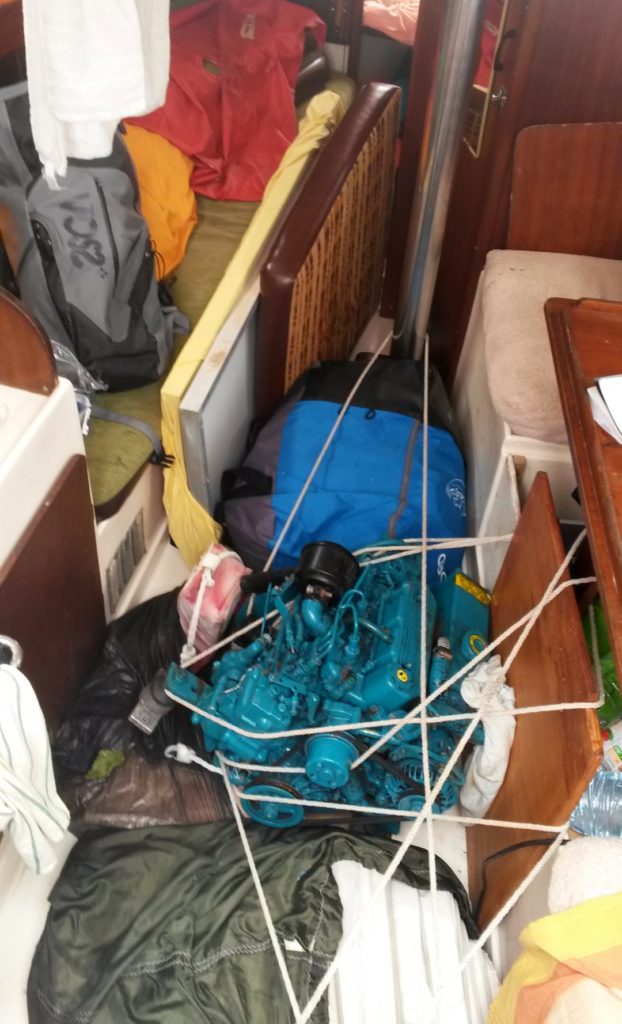
The night before came with the typical Antillais pre-hurricane attitude: eat, drink and be merry for tomorrow we die. There was an almost tangible undercurrent of excitement and emergency. Then I met Zen Master and kissed goodbye to the bateau, wondering if I’d ever see her again in one piece and if this was the end of all my sailing dreams before they’d really begun. I had sudden flurry of emotions: a new appreciation of her despite all the misery she’d put me through. She was broken and a burden, but she was mine. I wasn’t ready to lose her already. We retreated to his friend’s house to have my first (and not my last) hurricane party. Throughout the night we sat indoors and listened obsessively to the news, eating cheese and avocados from the garden and watching Indian films. I’d brought wine but they just raised their eyebrows at it (‘interesting choice…’) and went to get something better from the cupboard. If you’re British, don’t bother bringing wine to the French/Guadeloupeans. It will never be right.
The wind picked up a little bit over the night, but it was with a bizarre sense of disappointment muddled with elation that towards midnight we finally realised that our part of Guadeloupe had been spared… the hurricane had passed us by. The next morning we drifted about, checking for damage on the boats and listening in horror to what had gone down in islands further to the north. For my part I felt like my execution had been cancelled. The storm didn’t come. I still had my boat.
Maria, which arrived two weeks later, was another story. Our boats were already reasonably well prepared, so Zen Master and I headed back to land for round two of hurricane shelter. We helped his partner nail boards over the windows and gathered anything of value from the ground floor of the house to tidy away upstairs out of reach of flood water. In the marina teams were cutting down the glorious palm trees. For most of that day we’d thought the storm would be just a small one. We’d even toyed with the idea of staying on the boats (and some of the pirates in the marina were). But soon we realised that Maria was what they call a Barbadian – one that comes at the end of the season, forming quickly and augmenting fast. By the time it hit Martinique it was Cat 3 and was coming to us as Cat 5. Apocalypse mark two.
As the day progressed the wind and rain intensified and we watched the development on TV. Martinique got by in the end but Dominica was receiving a battering. Into the night it was incredibly loud outside, with disturbing banging coming from the roof. I was alone camped out on the sofa downstairs with water creeping in and getting steadily more scared. Around 1am I managed to get my dad on WhatsApp to give me news, which kept me calmer. The next morning we saw that the roof had blown off the gymnasium nearby. Eventually we felt it was safe enough to go back to the marina. This time there were definite signs of damage although most of the boats inside were OK. Those who’d sheltered in the lagoon were wrecked painfully on the harbour walls, and the pirates who’d stayed on board described the way my boat had heeled horizontal into the water, making me feel queasy. I met a guy who’d stayed on his boat on a mooring a little further down the coast. At some point he’d realised it was too dangerous to remain and had swum ashore with just a few possessions. His boat was now nowhere to be seen and he’d lost everything.
We listened to the news, heartbroken for our island cousins in Dominica. There were still stories of looting, anarchy and piracy coming in, as well as refugees from our badly hit neighbours. The aftermaths of both hurricanes are still being felt. Throughout the build-up I’d had hopes of leaving for Martinique raised and dashed, and tackled a series of boat work jobs I didn’t think I’d be capable of (including up-the-mast circus skills). I also learned a great deal about the weather. During hurricane season everyone in the tropics becomes a meteorological expert (and addicted to Mike’s Weather Page or the Martinique-based equivalent from Olivier Tisserant). You can’t help yourself, and each time the season comes around you ready yourself for the anxiety ride.
Have you experienced a hurricane and your boat lived to tell the tale? Leave a comment below.




About hurricanes. The only piece of advice (Usually I just received orders) I recall my mother (Your Grandmother) ever giving me was to prepare for the arrival of a hurricane in one of two ways. Either close all the doors and windows or open all the doors and windows. This was from experience while she lived with her parents in Antigua.
I experienced a Force 9 gale in the Indian Ocean on HMS Bulwark in 1970. There was an exceptional amount of vertical movement and water came over the island which is rare on an aircraft carrier. We lost all the ships boats and even some upper deck light fittings that had been welded on. My advice, get in your bunk and stay there until it goes away.